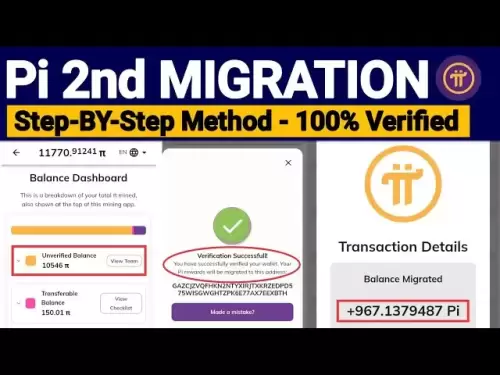-
 Bitcoin
Bitcoin $119,099.4533
1.28% -
 Ethereum
Ethereum $2,998.7451
1.92% -
 XRP
XRP $2.8591
4.59% -
 Tether USDt
Tether USDt $1.0003
0.00% -
 BNB
BNB $692.9775
1.20% -
 Solana
Solana $163.2224
1.61% -
 USDC
USDC $0.9999
0.00% -
 Dogecoin
Dogecoin $0.2019
2.15% -
 TRON
TRON $0.3038
1.17% -
 Cardano
Cardano $0.7478
5.84% -
 Hyperliquid
Hyperliquid $49.1367
5.40% -
 Stellar
Stellar $0.4751
23.39% -
 Sui
Sui $3.5069
3.10% -
 Chainlink
Chainlink $15.8345
5.24% -
 Hedera
Hedera $0.2431
24.24% -
 Bitcoin Cash
Bitcoin Cash $509.7593
0.14% -
 Avalanche
Avalanche $21.6872
4.67% -
 UNUS SED LEO
UNUS SED LEO $9.0317
-0.60% -
 Shiba Inu
Shiba Inu $0.0...01341
1.45% -
 Toncoin
Toncoin $2.9957
0.76% -
 Litecoin
Litecoin $96.5412
4.00% -
 Polkadot
Polkadot $4.0336
3.47% -
 Monero
Monero $337.6886
2.54% -
 Uniswap
Uniswap $8.6342
3.12% -
 Dai
Dai $0.9999
-0.01% -
 Ethena USDe
Ethena USDe $1.0006
0.01% -
 Pepe
Pepe $0.0...01252
1.99% -
 Bitget Token
Bitget Token $4.3967
0.70% -
 Aave
Aave $312.7622
4.15% -
 Bittensor
Bittensor $399.4937
3.72%
How to verify the authenticity of a used ASIC miner?
When buying a used ASIC miner, verify its authenticity through serial numbers, firmware checks, and manufacturer tools to avoid scams and ensure optimal performance.
Jul 13, 2025 at 09:08 pm

Understanding the Importance of Authenticity in Used ASIC Miners
When purchasing a used ASIC miner, verifying its authenticity is crucial to avoid falling victim to scams or acquiring faulty hardware. An authentic ASIC miner ensures optimal performance, reliability, and value for money. Many counterfeit units are sold online with falsified hash rates, altered firmware, or even rebranded defective models. Therefore, understanding how to authenticate these devices before purchase can save you from significant financial loss.
ASIC miners are specialized machines designed to mine cryptocurrencies like Bitcoin by performing complex hashing operations. Due to their high cost, many buyers opt for used units to reduce initial investment. However, the second-hand market is often flooded with refurbished or fake units that may not deliver promised performance.
Checking the Physical Condition and Serial Numbers
One of the first steps in verifying the authenticity of a used ASIC miner is to inspect its physical condition. Genuine manufacturers such as Bitmain (Antminer), Canaan (Avalon), and MicroBT (WhatsMiner) provide unique serial numbers on both the product itself and its packaging.
- Examine the casing for signs of tampering, mismatched screws, or poor quality printing.
- Check the serial number printed on the device against the one provided in the seller’s description or invoice.
- Compare the model number listed on the casing with the official specifications available on the manufacturer's website.
Manufacturers often maintain databases where users can input serial numbers to verify legitimacy. If the serial number doesn't match or cannot be found in the database, it may indicate a cloned or fake unit.
Analyzing Firmware and Hash Rate Performance
The firmware of an ASIC miner plays a key role in determining its performance and authenticity. Counterfeit or tampered units often run modified firmware that inflates hash rate readings or hides hardware defects.
To verify this:
- Access the miner’s web interface after connecting it to your local network via Ethernet.
- Check the firmware version and cross-reference it with the latest versions available on the manufacturer’s site.
- Observe the real-time hash rate during operation and compare it to expected values under similar conditions (temperature, power supply, etc.).
If the hash rate appears suspiciously high or unstable, further investigation is necessary. Some sellers use tools like “hash rate spoofing” to trick buyers into thinking the machine performs better than it actually does.
Using Manufacturer Verification Tools
Most reputable ASIC manufacturers offer online verification tools or support services to help customers check if a unit is genuine. These tools usually require entering the serial number or scanning a QR code located on the device.
For example:
- Bitmain provides a product verification portal where users can input their Antminer’s serial number to confirm authenticity.
- Canaan offers firmware integrity checks through its Avalon firmware update tool.
- MicroBT has a dedicated support system for checking the status of WhatsMiner units using IMEI or serial codes.
These verification systems not only confirm authenticity but also reveal whether the unit has been reported stolen or blacklisted due to previous malfunctions.
Consulting Community Forums and Seller Reputation
Before completing a transaction, researching the seller and consulting cryptocurrency mining communities can provide valuable insights. Platforms like Reddit, BitcoinTalk, and specialized ASIC miner forums host discussions where users share experiences about particular sellers or models.
Here’s what to look for:
- Seller feedback and reviews on platforms like eBay, AliExpress, or Bitcointalk marketplace threads.
- Community warnings about specific batches of miners known for being counterfeit.
- Verified user reports comparing performance metrics of certain models across different sources.
Engaging directly with community members who have experience with the same model can give you realistic expectations and red flags to watch out for when evaluating a used ASIC miner.
Frequently Asked Questions
Q: Can I trust third-party verification services for ASIC miners?
While some third-party services claim to verify ASIC miner authenticity, it's best to rely on official manufacturer tools. Third-party verifications may lack accuracy or access to proprietary data.
Q: How do I know if the firmware has been tampered with?
Signs of tampered firmware include unusual hash rate fluctuations, unresponsive interfaces, or inability to update through official channels. Always download firmware updates directly from the manufacturer’s site.
Q: What should I do if I suspect a miner is counterfeit?
Immediately stop using the device and contact the manufacturer with the serial number. Report the seller to the platform where the purchase was made and consider legal action if applicable.
Q: Is there a way to test the longevity of a used ASIC miner?
Run stress tests over several hours and monitor temperature, fan speed, and hashrate stability. Review maintenance logs if available and assess wear and tear on components like fans and PCB boards.
Disclaimer:info@kdj.com
The information provided is not trading advice. kdj.com does not assume any responsibility for any investments made based on the information provided in this article. Cryptocurrencies are highly volatile and it is highly recommended that you invest with caution after thorough research!
If you believe that the content used on this website infringes your copyright, please contact us immediately (info@kdj.com) and we will delete it promptly.
- BlockDAG, BONK, XRP: What's Hot and What's Not in the Crypto World
- 2025-07-14 03:30:16
- AI Predicts XLM Price Surge: Will Stellar Reach New Heights?
- 2025-07-14 02:50:16
- Kate Middleton, Wimbledon, and a Brave Young Cancer Patient: A Royal Day at the Championships
- 2025-07-14 02:30:16
- Memecoin Mania: Pump.fun's $600 Million Blitz – What's the Deal?
- 2025-07-14 02:30:16
- Solana Price Dip: Is Now the Time to Buy Crypto?
- 2025-07-14 03:50:12
- Crypto Acquisitions Heat Up: OpenSea, PumpFun, and the NFT Revolution
- 2025-07-14 02:50:16
Related knowledge

How are crypto mining profits taxed?
Jul 14,2025 at 12:28am
Understanding Cryptocurrency Mining and TaxationCryptocurrency mining involves validating transactions on a blockchain network and earning rewards in ...

How to keep a mining rig cool
Jul 12,2025 at 01:42pm
Understanding the Importance of Cooling in Mining RigsCryptocurrency mining is an intensive process that places heavy demand on hardware components, p...

How much does it cost to start crypto mining?
Jul 13,2025 at 12:22am
Understanding the Basic Costs of Crypto MiningStarting crypto mining involves several upfront and ongoing expenses. The primary costs include hardware...

What is the most profitable crypto to mine?
Jul 13,2025 at 07:00am
Understanding Mining Profitability in CryptocurrencyWhen evaluating the most profitable crypto to mine, it's essential to consider several factors tha...

What do I need to start mining crypto?
Jul 13,2025 at 12:28am
Understanding the Basics of Crypto MiningCrypto mining is the process by which transactions are verified and added to a blockchain, and new coins are ...

How does crypto mining work?
Jul 13,2025 at 11:01am
Understanding the Basics of Crypto MiningCrypto mining is the process through which new cryptocurrency coins are introduced into circulation and trans...

How are crypto mining profits taxed?
Jul 14,2025 at 12:28am
Understanding Cryptocurrency Mining and TaxationCryptocurrency mining involves validating transactions on a blockchain network and earning rewards in ...

How to keep a mining rig cool
Jul 12,2025 at 01:42pm
Understanding the Importance of Cooling in Mining RigsCryptocurrency mining is an intensive process that places heavy demand on hardware components, p...

How much does it cost to start crypto mining?
Jul 13,2025 at 12:22am
Understanding the Basic Costs of Crypto MiningStarting crypto mining involves several upfront and ongoing expenses. The primary costs include hardware...

What is the most profitable crypto to mine?
Jul 13,2025 at 07:00am
Understanding Mining Profitability in CryptocurrencyWhen evaluating the most profitable crypto to mine, it's essential to consider several factors tha...

What do I need to start mining crypto?
Jul 13,2025 at 12:28am
Understanding the Basics of Crypto MiningCrypto mining is the process by which transactions are verified and added to a blockchain, and new coins are ...

How does crypto mining work?
Jul 13,2025 at 11:01am
Understanding the Basics of Crypto MiningCrypto mining is the process through which new cryptocurrency coins are introduced into circulation and trans...
See all articles
























































































